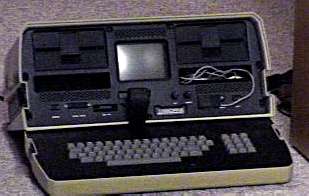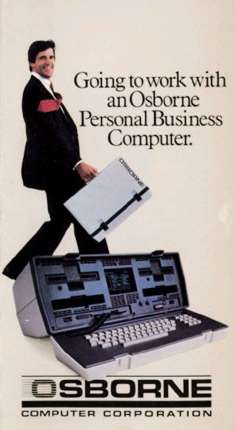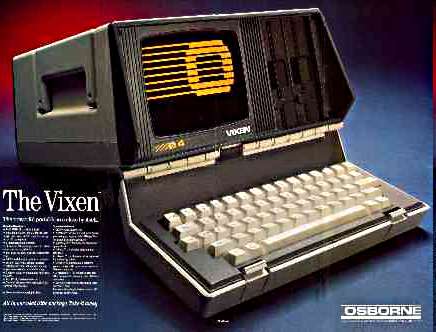| Adam Osborne Serial Entrepreneur |
| Written by Historian | |||
|
Entrepreneurs play a very special role in the development of computing. If you understand the technology well enough then it is difficult not to see opportunities for making a profit. What seems to be difficult is to actually manage the business side of things to realise the profit locked up in the new technology. In other areas a single attempt is all that would be possible - but computing seems to be so fertile that some people can manage not one, not just two but three or more start-up companies that just keep on hitting the headlines. You may not remember the name of Adam Osborne as easily as Steve Jobs say, but there was a time when he was as, if not more, famous. If you read computer books, use a portable or just use low cost software then you should know a little more about Adam Osborne. Adam Osborne 1939-2003
Osborne was born in Bangkok. His father taught history at the local university. During World War II he was evacuated to southern India where he lived until he was 11. He was educated in a Catholic school where he quickly learned that a quieter life was had by Catholic pupils - so he converted. When he was 11 he moved to the UK and went to school near Birmingham and then on to Birmingham University to study chemical engineering. After graduating he went to the US. Not for money but for love - his girlfriend moved there first and he followed. After working as a chemical engineer he decided that it was not for him and so he enrolled as a doctoral student. He studied chemical engineering but chose computers as the subject of his thesis which was completed in 1968. Chemical engineering and computers made his next move to Shell Oil to work on mathematical modelling seem natural, but within three years he was fired. Osborne claims that he was an aggressive over-achiever and often disagreed with his bosses. The obvious next step was to start a company of his own and Osborne and Associates was founded. Almost immediately they got their first job - writing technical manuals for General Automation. In two years Osborne had fifteen people working for him and then General Automation changed their management and started to write their own manuals. The first micro bookDuring this time Osborne had written a book - oddly titled The Value of Power about microprocessors. He expanded it and renamed it An Introduction to Microprocessors but no one wanted to publish it. This may seem strange in these days of the huge PC book industry but back then it wasn't at all clear that any one would be interested in a book on "microprocessors". After all a microprocessor was just a single chip and you needed to put a lot of electronics with it to make anything at all - and the result could only be called a computer if you stretched the point. Osborne thought that there would be a lot of interest in a book on microprocessors and so he published it himself. It was successful - very successful. It sold 300,000 copies and Osborne and Associates became a publisher. They produced forty books on computers in five years. Adam Osborne himself wrote twelve or so of them. You could credit him with starting the computing book publishing industry as we know it but in a sense he also helped start the personal computer revolution. The reason is that Osborne books help educate and inform the people who built the early machines. Osborne made the information available to enthusiasts as well as professionals.
A little known fact is that when Paul Allen and Bill Gates decided to implement a version of Basic for the Intel 8080 the first job was to write a simulator for the PDP-10 that they were using. The instruction codes and how everything worked was taken from an Adam Osborne microprocessor book that listed the entire 8080 instruction set. Just think a few printing errors and Microsoft might never have come into existence. The publishing phase of Osborne's progress came to an abrupt end when he sold out to McGraw Hill in 1979. Osborne Books continues to this day as an imprint of McGraw Hill. The purchase price has never been revealed but it is rumoured to have been in the $3 to $10 million range! His final legacy to them was a book called Running Wild - The Next Industrial Revolution which speculated on the future of the micro and personal computer. From books to computersIn 1980 he decided that his next challenge would be to make computers portable. This may not seem much of a challenge now that we have laptops and netbooks - but then it seemed ridiculous. Personal computers of the era were mostly based on the current-guzzling Z80 processor and they were hot and huge. Even the standard disk drives of the day were 5.25 inch full height devices and there were no LCD screens. Put in this context you can see that Osborne's scheme seemed an idea that would be easier to leave for a few years. He found the man to do build his machine at the West Coast computer fair. Lee Felsenstein was already a veteran designer. He had founded the Homebrew Computer Club and helped and inspired many others build their own machine - including Jobs and Wozniak. Osborne described the specification of his machine to Felsenstein - it had to be strong, small, cheap and easy to build. The Osborne 1The prototype took four months and cost $28000. The machine was remarkable. A single PC board contained a Z80 processor, memory, a video display and a disk controller. The PC board was designed to slide into a moulded plastic case about the size of an small suitcase. A five inch CRT was fitted in the centre of the case providing a 52 character per line display. Needless to say that it was black and white! A pair of full height 5.25 inch drives sat each one each side of the monitor. You needed two because one had to hold the program disk while the other held the data disk - remember each one only had a 360KByte capacity.
The Osborne I
A less essential feature was the strange well under each drive moulded into the case. Users were intended to store their diskettes in these pockets - but many were very worried about storing magnetic disks right under the influence of the disk drive motors. It also had to be a mains powered unit and the mains lead coiled up in the base of the case. It weighed over twenty pounds and a new term had to be introduced to describe it - lugable as opposed to portable. It was designed to fit under an aeroplane seat but only if you had the strength to get it up the steps!
The Osborne I was a remarkable machine and it sold well. It was the only option if you wanted a portable of any sort - and it was priced so that you couldn't ignore it even if portability wasn't of any interest. At $1700 it was cheaper than any equivalent desktop. The final killer blow was an idea that Osborne had to bundle software with the machine. It came complete with Wordstar, SuperCalc, Microsoft Basic and CBasic. The software alone cost $2000 and the joke at the time was that Osborne was selling the software and giving the machine away! Osborne Computer Corporation (OCC) achieved $1 million per month one year after the launch. Clearly OCC was to become a force in personal computing - but things weren't all perfect. Perhaps the biggest problem was that the IBM PC had just made its debut and the world was about to change. The Osborne I was an 8-bit CP/M machine and everyone was very clear that this was not the standard for even the near future. With 500 employees and a turnover of $10 million a month Adam Osborne decided that what was needed was professional management. He chose Robert Jaunich from Consolidated foods to take over - a decision he would always regret. To do battle with the IBM PC, OCC had two new machines waiting in the wings. The Executive had a 7-inch screen and sold for little more than the Osborne I and the Vixen a smaller even cheaper machine. Unfortunately OCC committed the most naive of blunders - it announced the new machines while the distribution channel still had large stocks of Osborne Is and while there was no chance of supplying the new machines. Sales fell through the floor - from 10,000 per month before the announcement to 100 per month after! There were 20,000 unsold Osborne I's in stock with no chance of being cleared. Adam Osborne himself claims that he recommended that the new machines should not be announced but the new management and he did not see eye-to-eye.
The Vixen In the summer of 1983 price cuts on the Osborne I were introduced but they did little to help the company's situation. OCC went bankrupt at the end of the summer with liabilities of $45 million and over 600 creditors. It was the first major failure in the new and vigorous PC industry and it signalled a change in climate. Lots of new PC companies had failed to manage their explosive growth but OCC was the first to suffer for it. Paperback softwareAs you would expect, the loss of OCC wasn't really a setback to Adam Osborne. He still had ideas and one of the best was the bundling of software with the OsborneI. In 1984 he decided to start another new company - this time without Osborne name in the title - PaperBack Software. This wasn't such a huge step as back in the early days many of Osborne's books were just printed program listings, i.e. published software but without the disks. You can imagine that getting the money to start a low cost software marketing venture was not easy for a man whose hardware company had just failed. He did get some cash though and put in $100,000 of his own. Finally in desperation he issued six million ten cent shares on the penny stock market. The offer sold out, raising half a million dollars. The dream he was selling was cheap software. Spreadsheet programs for $100 and not the $500 that the big companies demanded. Some of these programs he would develop, others would be obtained by marketing agreements with smaller companies. He also decided to adopt a smaller cheaper format for publishing software. Each manual would be in the form of a paperback book with the software bound into the cover. At the time most software was sold in huge library cases to try to give the impression that you were getting more for your money than just bits... PaperBack soon had a good collection of products - VP-Planner, VP-Info and NewWord to name only the most important. These were all good programs sold at a reasonable price but there was one fly in the ointment - they were compatible with the then market leaders. VP-Planner was a Lotus 1-2-3 compatible spreadsheet, VP-Info was compatible with dBase and NewWord with Wordstar. Not that they were slavish copies, each went beyond the originals in some way. VP-Planner for example, was one of the first spreadsheets to introduce multi-dimensional worksheets. However Lotus decided to sue PaperBack software over the copying of the "look-and-feel" of its product. The case dragged on for some time but eventually Lotus won and PaperBack Software US went bankrupt. After PaperBack Software Adam Osborne seems to have given up the idea of running large companies. He moved to India in 1992 in ill health and died in 2003.
<ASIN:0262532034> <ASIN:0071358927> <ASIN:0470402377> <ASIN:1590597214> <ASIN:0141000511> <ASIN:0079310281> <ASIN:0262532034> <ASIN:0887309895> 0262532034> |
|||
| Last Updated ( Thursday, 11 January 2018 ) |






